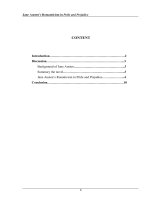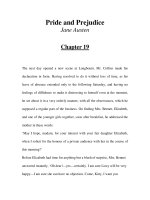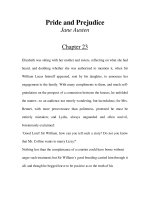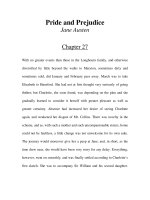Jane Austen’s Romaticism in Pride and Prejudice
Bạn đang xem bản rút gọn của tài liệu. Xem và tải ngay bản đầy đủ của tài liệu tại đây (134.17 KB, 10 trang )
Jane Austen’s Romanticism in Pride and Prejudice
CONTENT
Introduction……………………………………………………………2
Discussion……………………………………………………………...3
Background of Jane Austen………………………………………..3
Summary the novel………………………………………………...3
Jane Austen’s Romaticism in Pride and Prejudice………………...4
Conclusion…………………………………………………………….10
1
Jane Austen’s Romanticism in Pride and Prejudice
INTRODUCTION
Rationale
English literature is an interesting subject which provides us a broad view of England with
the tradition culture, and people within a concrete social and historical context, in which
Literature of the beginning of the 19
th
century in England was marked with the triumph of
many famous novelists, such as:William Wordsworth, Robert Burns, Jane Austen, Samuel
T Coleridge…of which I was deeply impressed the novelist: Jane Austen. Austen's novel
is principally concerned with the social fabric of late eighteenth- and early nineteenth-
century England, a patriarchal society in which men held the economic and social power.
One of the world's most popular novels, Jane Austen's Pride and Prejudice has delighted
readers since its publication with the story of the witty Elizabeth Bennet and her
relationship with the aristocrat Fitzwilliam Darcy. Similiar to Austen's other works, Pride
and Prejudice is a humorous portrayal of the social atmosphere of late eighteenth- and
early nineteenth-century England, and it is principally concerned with courtship rituals of
the English gentry. The novel is much more than a comedic love story. That is the reason
why I choose Jane Austen and her novel Pride and Prejudice for my assignment.
Method of the study
In order to carry out assignment well, I have tried consulting, reading many
reference books and other resources of materials relating to English literature and novelist
Jane Austen as well.
In the assignment, I have analyzed Jane Austen’s romanticism through the four
marriages, Elizabeth and Jane Austen’s outer sensibility and inner romanticism.
Design the study
The assignment is divided into three main parts:
Introduction: includes the rationale, method of the study and design of the study.
The discussion of the assignment consists of background of Jane Austen, summary
novel Pride and Prejudice and specially Jane Austen’s romanticism in this novel.
The last one is the conclusion
DISCUSSION
2
Jane Austen’s Romanticism in Pride and Prejudice
Background of Jane Austen
Jane Austen was a major English novelist, whose brilliantly witty, elegantly structured
satirical fiction marks the transition in English literature from 18
th
century neo-classicism
to 19
th
century romanticism. She was born on 16 December 1775, at the rectory in the
village of Steventon, near Basingstock in Hampshire.Her father was a country minister in
Stevensen while her mother was a housewife who was interested in literature and could
write stories and poems. Jane Austen, with her sisters, was educated at home and passed
her life very quietly but cheerfully in the doing of small domestic duties “to which love
lights the magic lamp that makes all things beautiful”. (James Edward, 1985: 231) As a
teenager, Jane Austen showed wit and liveliness in her writing and her stories were shared
by all her family and her earliest writing dates from about 1787. During the forty-two
years of her life, Austen had completed six novels: Northanger Abbey, Persuasion, Sense
and Sensibility, Pride and Prejudice, Mansfield Park and Emma and left behind three
fragments. By May 1817,she was so ill that she and Cassandra, to be near Jane’s
physician, rented rooms in Winchester. Tragically, there was then no cure and Jane died in
her sister’s arms in the early hours of 18 July 1817. She was 41 years old. She was buried
in Winchester cathedral.
Summary the novel
Pride and Prejudice focuses on Elizabeth Bennet, an intelligent young woman with
romantic and individualistic ideals, and her relationship with Mr. Darcy, a wealthy
gentleman of very high social status. At the outset of the novel, Elizabeth's loud and dim-
witted mother, her foolish younger sisters, and her beautiful older sister Jane are very
excited because a wealthy gentleman, Mr. Bingley, is moving to their neighborhood. The
young women are concerned about finding husbands because if Elizabeth's father, a
humorous and ironical man, were to die, the estate would be left to their pompous cousin
Mr. Collins. Mr. Bingley soon becomes attached to Jane while
Elizabeth grows to dislike his close friend Mr. Darcy, whom the village finds elitist and
ill-tempered. Under the influence of his sisters and Mr. Darcy, Mr. Bingley eventually
3
Jane Austen’s Romanticism in Pride and Prejudice
moves away to London. Mr. Collins, an irritating clergyman, then proposes to his cousin
Elizabeth, who refuses him. He marries her friend Charlotte instead, and Elizabeth visits
the couple at their estate, where she and Mr. Darcy meet again at the house of his aunt,
also Mr. Collin's patroness, Lady Catherine de Bourgh. Mr. Darcy proposes to Elizabeth
but she refuses him, partly based on her belief that he dissuaded Mr. Bingley from
pursuing a relationship with Jane. In a letter to Elizabeth, Mr. Darcy explains his actions
regarding Jane and Mr. Bingley, as well as the way in which he has treated his estranged
childhood companion, Mr. Wickham. The next time Elizabeth sees Mr. Darcy, at his
estate, she is better disposed toward him, but they are interrupted by a scandal involving
Elizabeth's sister Lydia, who has eloped with Mr. Wickham. Mr. Bennet and his brother-
in-law Mr. Gardiner attempt to resolve the situation, but it is actually Mr. Darcy who
resolves the situation by paying Mr. Wickham and convincing him to marry Lydia. Mr.
Bingley then returns to his estate in the Bennets' neighborhood and soon becomes engaged
to Jane. Afterward, despite Lady Catherine's attempt to prevent the engagement, Elizabeth
marries Mr. Darcy.
Jane Austen’s Romanticism in Pride and Prejudice
The four marriages
Through the novel Pride and Prejudice, we can see that Jane Austen, besides of
mainly concentrating on modeling the characters Elizabeth and Darcy and portraying the
complicated love and marriage between them; also pays much attention to depicting many
other roles and three other marriages. In each of these marriages, properties, status, love,
beautiful appearance exert different influence and these four marriages are combinations
for profit, for moral, for lust and for love.
Firstly, let’s come to see the marriage for profit. In this novel, Mr. Collins and
Chalotte Lucas is the first couple. In their marriage, property plays a decisive part for this
marriage, which is a typical example of the very social marriage situation and has a
practical significance. On the one hand, Chalotte is twenty-seven years old girl and
somewhat homely. Even though she has a good education before, she has little property.
And for her, to marry basing on a comfortable life is the best marriage. So when she
4
Jane Austen’s Romanticism in Pride and Prejudice
notices that Mr. Collins, a minister with money and status makes an offer of marriage to
her, she accepts his proposal immediately without thinking whether there is love and same
tastes between them. On the other hand, for Mr. Collins, marriage just means a model for
parish and in his mind marriage could add happiness for him and even marriage is what
Mrs.Catherine(a sponsor of Mr.Collins) thinks he should find a wife with great ability to
help him manage home. In their marriage, each of them takes what they want; yet only
love is not needed. This marriage makes a good demonstration of Jane Austen's viewpoint
that beyond love, romantic affair, a marriage is due to be a failure. On the contrary, a
successful marriage should contain the element of love.
Secondly, Jane Austen describes a lust marriage in the story. She views that a
marriage based on lust is immoral and unhappy. Mr.Whickham and Lydia Bennet are
related by pretty appearance and lust. Lydia is pleasure-seeking and Whickham only likes
her youth and health. At the same time, Lydia’s so-called love for Whickham is so
superficial that after they marry, they would live on an unhappy life. It is mainly because
no real love exists between them.
Thirdly, Jane Bennet and Mr. Bingley’s marriage is full of admonition. In Pride
and Prejudice, Jane is the embodiment of virtue and she is good at restraining her own
passion. She pursues happiness under the condition that she must obey the moral
standards. So, the author still arranges a happy marriage for her. After all, it is Austen’s
view that love is the basis and the happiness is the destination of a marriage. In the novel
we can find without any difficulty that Jane and Bingley love each other deeply. However,
Jane is extremely in lack of courage to disobey the traditional love standard because Jane
never shows her love to Bingley or others though she loves Bingley very much. And she
does not seeks Bingley’s love positively even when she knows that Bingley will leave
Nrtherfiled Park and will not come back again. Whereas, Bingley is too easy-minded to
make sure his love and Jane’s love so that their happy combination is obstructed again and
again. From their marriage, we can find clearly that Jane is dependent on her virtue to get
a satisfactory marriage. The author encourages people to
do well through Jane’s virtue and tells readers: a happy marriage must come from true
love between lovers.
5









